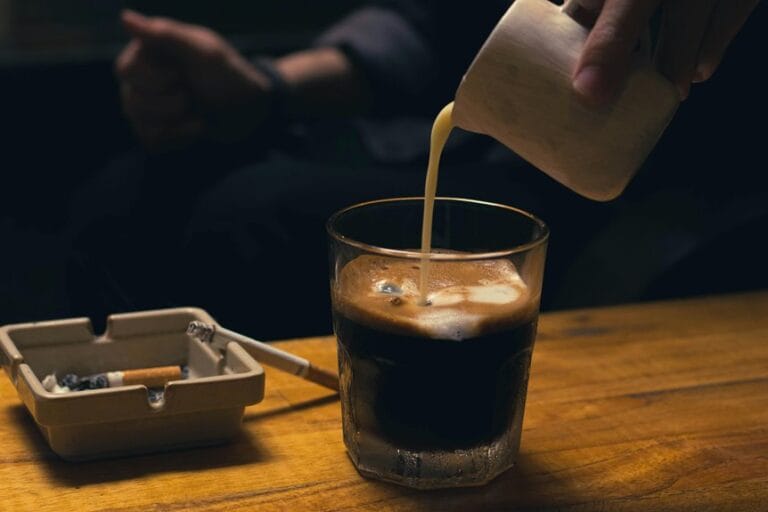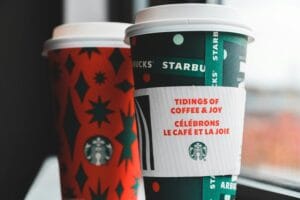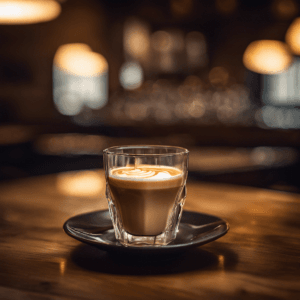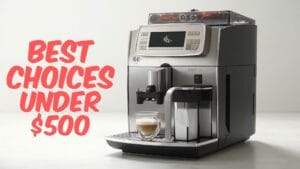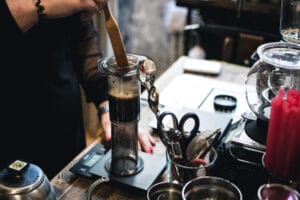Espresso seems stronger, but drip coffee often packs more caffeine in general, since a small espresso shot (63-108 mg) can’t match the caffeine in a full drip cup (96-128 mg per 8 oz). Dark roasts? They’re bitter but not higher in caffeine—blonde roasts win there. Manage intake by choosing espresso for quick enhancements (1-2 shots) or drip for slow sipping, tracking totals (max 400 mg/day). Mixing both? Now there’s a fun balancing act… stay tuned for smarter sips ahead!
The Espresso Caffeine Misconception
Many think espresso is a caffeine powerhouse, but here’s the twist: ounce for ounce, it packs more punch, yet typical servings tell a different story. A single espresso shot (1-2 oz) delivers about 63 mg of caffeine, while an 8-ounce brewed coffee offers 96-128 mg—nearly double the kick! Drip coffee typically has a higher total caffeine content than espresso when brewed in larger sizes.
Espresso’s reputation comes from its concentrated sips, not total caffeine. People down it quickly, feeling a rapid jolt, while coffee drinkers nurse their mug slowly.
The truth? Your average drip coffee stealthily sneaks in more caffeine over time. Choosing espresso can mean less total intake, but only if you stick to one shot. Keep in mind that the caffeine content in an Americano is directly linked to the number of espresso shots used.
Coffee freedom means knowing the numbers: strength≠quantity. Size matters more than swagger when managing your buzz.
Common Coffee Caffeine Myths Debunked
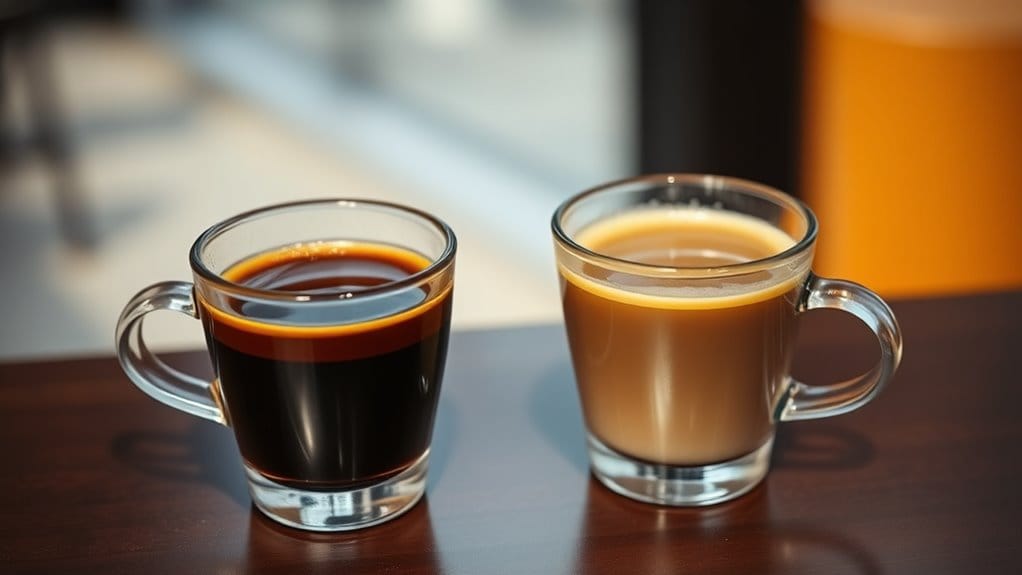
Many believe espresso packs more caffeine just because it’s strong and thick, but a tiny espresso shot actually has less caffeine than a full cup of drip coffee, so bigger sips matter! Additionally, the average caffeine concentration of blonde roast coffee is higher than that of dark roast, making it a better choice for those seeking a higher caffeine level.
Others confuse bitterness with strength, blaming caffeine for dark roasts’ bold taste, when really it’s the roasting process creating that smokey flavor, not extra jolt power. These sneaky mix-ups trick drinkers daily, turning coffee myths into “facts” faster than a barista can steam milk! Furthermore, espresso is brewed under specific parameters that affect its flavor and caffeine content.
The Density Myth
One coffee myth that just won’t quit claims dark, bold roasts pack more caffeine because they’re “stronger” in flavor, or look oilier, or feel denser—but that’s backward!
Truth is, dark roasts lose mass during extended roasting, leaving beans less dense and lower in caffeine per scoop. Lighter roasts, roasted shorter, retain more caffeine, defying the “dense” illusion. Additionally, Arabica coffee’s growth at 1,200-1,800 meters altitude contributes to its unique flavor and caffeine profile, influencing the roasting process.
Drip coffee’s caffeine content depends on how grounds are measured: using scoops? Darker beans take up less space, so you might use fewer grounds (and less caffeine). But dark roasts brew weaker if measured by weight—science vs. perception!
Most drip coffee uses standard scoops, meaning lighter roasts sneak in extra caffeine. Coffee’s sneaky like that. Slow drying preserves cherries during storage, affecting the final product’s caffeine potency. Want freedom from myths? Skip assumptions—follow the beans, not the oils.
Bitterness vs Caffeine Confusion
While darker roasts might shrink under heat but keep their caffeine, bitterness stirs its own myth: a harsh taste doesn’t mean more caffeine.
Bitter flavors often come from longer roasting or brewing methods, not the caffeine content of espresso. A single espresso shot packs 63 mg per ounce, but since it’s tiny—usually 2 oz—it’s often weaker in total caffeine than a full cup of drip coffee, which can hit 120 mg in 12 oz. Interestingly, both espresso and drip coffee brewing methods are influenced by common preparation techniques that can affect taste.
Lighter roasts, though milder, often have slightly more caffeine than dark ones. Think of it like snacks: a spicy chip isn’t stronger, just bolder.
Interestingly, direct trade partnerships allow for better quality control and ethical sourcing, contributing to the overall flavor profile of the coffee.
Next time someone says “bitter equals more kick,” sip slowly. The truth? Concentration isn’t king—volume and brewing science call the shots.
Scientific Caffeine Comparison
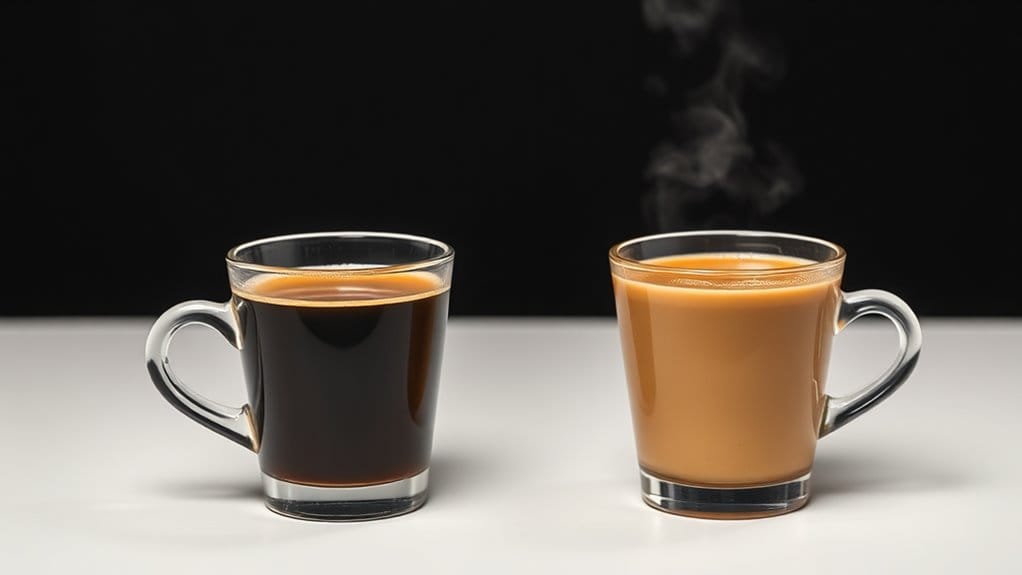
Espresso packs more caffeine per ounce than drip coffee, but drip usually delivers more caffeine in total because it’s served in bigger cups! The difference comes down to brewing: espresso uses high pressure, quick shots (like a superhero speed increase), while drip coffee brews slowly with gravity, spreading the caffeine evenly. Think of espresso as a quick jolt and drip as a slow drip, but many factors—grind size, water temps, even how fast you drink—change the caffeine you get. The specific type of coffee bean used (Arabica vs. Robusta) plays a crucial role in caffeine levels, with Robusta beans naturally containing almost double the caffeine of their Arabica counterparts. Additionally, Robusta’s high caffeine content is part of its genetic makeup, which contributes to its pest resistance and overall hardiness. Furthermore, espresso beans typically require careful roasting to optimize their flavor and caffeine qualities. Light roasts also contribute to caffeine differences, offering slightly more caffeine per gram than dark roasts due to their denser structure.
| Espresso | Drip Coffee |
|---|---|
| 63-75 mg per 1 oz shot | 12-16 mg per oz |
| Brewed under pressure (25 sec) | Brewed with gravity (5+ mins) |
| Small serving size (1-2 oz) | Standard serving (8+ oz) |
| Fast, intense caffeine hit | Gradual caffeine release |
| Stronger per sip | Milder taste, higher total |
Espresso vs Drip Caffeine Measurements
When comparing the jolt of espresso to the slow burn of drip coffee, it’s all about concentration and cup size.
How much caffeine is in espresso coffee? A single shot (2 oz) packs 60–100 mg, while a standard 8 oz drip coffee serves 95–200 mg, depending on beans and brewing.
Ounce for ounce, espresso wins—about 63 mg per fluid ounce versus drip’s 12–16 mg.
But drip’s bigger servings mean more total caffeine: a 12 oz cup can hit 247 mg, dwarfing a single shot.
To match café-sized brews, espresso drinkers would need multiple shots—like four for Starbucks’ 410 mg venti.
The rebel take? Choose espresso for concentrated power, drip for marathon sipping.
Either way, caffeine freedom lies in controlling intake, one bold sip or slow pour at a time.
Extraction Principles and Variables
Caffeine extraction in coffee isn’t just magic—it’s science in action, like a sneaky wizard pulling flavor and kick from beans.
Finer grinds, like espresso’s powdery texture, expose more surface area to water, yanking caffeine quickly (127 mg per 2 oz shot!). Note how particle size distribution impacts extraction: narrow ranges minimize bitter fines while maximizing efficiency. The trick lies in balanced extraction parameters—too coarse leads to weak brews, excessively fine creates bitter overkill. Pressure matters: espresso machines blast 9 bars through grounds in 25 moments, while drip coffee lets gravity do the work over minutes.
Temperature joins the party—water near boiling (95–105°C) dissolves caffeine fast, but cold brew needs hours.
Saturation is key: water must hug every coffee particle, grabbing all that zing.
Though espresso packs caffeine tighter per sip, a full 8 oz cup of drip often wins the caffeine race, revealing 95–200 mg by soaking longer.
Choose your brew: quick magic or slow science!
Practical Caffeine Management Guide
Balancing caffeine intake requires understanding daily limits and tailoring coffee choices to daily needs.
- Stick to 400 mg of caffeine max—that’s roughly three cups of drip coffee or five espresso shots.
- Opt for espresso when you need a quick energy spike, brewed coffee for slower sipping, and decaf if cutting back.
- Track servings with simple tricks, like noting each cup or swapping large lattes for smaller options to avoid the “coffee jitters” later.
Daily Limits and Coffee Equivalents
Coffee lovers facing math class vibes, here’s the deal: health experts say most adults can safely enjoy up to 400 mg of caffeine daily, about three shots of espresso or two tall coffees from Starbucks.
A 2 oz espresso shot packs roughly 108 mg of caffeine—strong, but small, letting you balance intake without overdosing.
Compare that to drip coffee: a 12 oz cup holds 95-200 mg, so two cups might hit the daily max.
Commercial giants skew numbers: Starbucks’ tall brews hit 260 mg, while home-brewed saves wiggle room.
Think double shots? That’s 200+ mg, equal to chugging a venti brew.
Watch total intake, mix espresso and drip, and factor in decaf sips for those craving freedom without jitters.
Know your beans, track your shots, and keep that caffeine math simple.
Choosing Your Coffee: Situation-Based Guide
Whether racing to meet a deadline or savoring a lazy Sunday brunch, picking the right coffee can mean the difference between feeling like a superhero and resembling a sleepy housecat.
Need a fast, focused jolt? A single espresso shot (around 127 mg caffeine) packs a punch in two ounces, perfect for quick energy before a meeting or workout.
Prefer sipping slowly? Drip coffee’s 95–200 mg per 8 oz cup lets you linger, stretching caffeine absorption over hours, ideal for lazy afternoons or casual chats.
Craving balance? Opt for a latte—espresso’s boldness mellowed by milk, blending flavor with controlled caffeine.
For late-day sips, decaf (2–15 mg) avoids sleep sabotage.
Match your brew to your mood, timing, and desired vibe, turning caffeine into a tool, not a tyrant.
Frequently Asked Questions
Does Caffeine Affect Heart Rate Differently in Espresso Versus Drip Coffee?
Caffeine’s impact on heart rate depends on total consumption and ingestion speed. Espresso’s concentrated dose, often consumed rapidly, may cause quicker cardiovascular response, while drip coffee’s higher cumulative caffeine can prolong effects. Individual tolerance and intake volume are key.
Can Brewing Time Reduce Caffeine Content in Espresso?
Brewing time minimally impacts caffeine content in espresso, as most caffeine extracts rapidly under pressure. Slight variations (e.g., 20 vs. 30 moments) yield negligible differences, given caffeine’s high solubility in pressurized, short extractions.
What Coffee Alternatives Have Less Caffeine Than Espresso or Drip?
Decaf coffee averages 2-15 mg caffeine per 8 oz versus espresso’s 108 mg. Alternatives include herbal teas (chamomile: 0 mg), matcha (18-50 mg), yerba mate (30-50 mg), or chicory—naturally caffeine-free options catering to varied preferences.
How Does Personal Caffeine Sensitivity Influence Espresso Versus Drip Choice?
Personal caffeine sensitivity dictates beverage choice through tolerance to dosage and absorption rate. Highly sensitive individuals may prefer single espresso shots (63mg) over larger drip servings (96-128mg/8oz), adjusting for rapid versus gradual intake.
Does Consuming Espresso on an Empty Stomach Increase Caffeine Absorption Speed?
Like a sprint lane freed from traffic, espresso on an empty stomach bypasses digestive buffers, liberating caffeine to surge swiftly into the bloodstream through undiluted gastric pathways, potentially sharpening absorption velocity.

